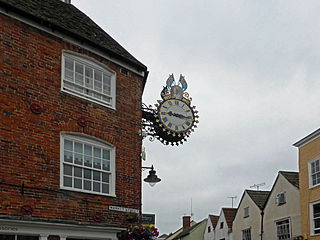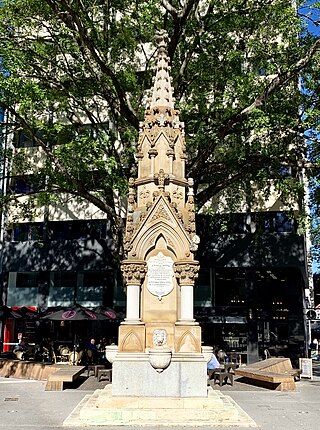
Albert Square is a public square in the centre of Manchester, England. It is dominated by its largest building, the Grade I listed Manchester Town Hall, a Victorian Gothic building by Alfred Waterhouse. Other smaller buildings from the same period surround it, many of which are listed.

Eastgate is a permanently open gate through the Chester city walls, on the site of the original entrance to the Roman fortress of Deva Victrix in Chester, Cheshire, England. It is a prominent landmark in the city of Chester and the Eastgate clock on top of it is said to be the most photographed clock in England after Big Ben.

The Buxton Memorial Fountain is a memorial and drinking fountain in London, the United Kingdom, that commemorates the emancipation of slaves in the British Empire in 1834, and in particular, the role of British parliamentarians in the abolition campaign.

Albert Park is a public park in central Auckland, bounded by Wellesley Street East, Princes Street, Bowen Avenue and Kitchener Street. From the entrance at the corner of Bowen Ave and Kitchener St, sealed footpaths climb steeply through native trees to the large flat area at the summit, where a formal layout of paths and flower gardens encircle a fountain.

Jubilee clock is a term used in reference to a number of clocks constructed and erected throughout the British Empire in commemoration of the Golden or Diamond Jubilee of various British monarchs, most commonly, Queen Victoria's.

St Martin's Church is in Church Lane, Ashton upon Mersey, a district of Sale, Greater Manchester, England. It is recorded in the National Heritage List for England as a designated Grade II* listed building. It is an active Anglican parish church in the diocese of Chester, the archdeaconry of Macclesfield and the deanery of Bowdon.

Cliffe Castle Museum, Keighley, West Yorkshire, England, is a local heritage museum which opened in the grand, Victorian, neo-Gothic Cliffe Castle in 1959. Originating as Cliffe Hall in 1828, the museum is the successor to Keighley Museum which opened in Eastwood House, Keighley, in c. 1892. There is a series of galleries dedicated to various aspects of local heritage, and to displaying the house itself, which is a Grade II listed building. Entrance to the museum is free of charge.

Halifax Town Hall is a grade II* listed, 19th century town hall in the town of Halifax, West Yorkshire, England. It is notable for its design and interiors by Charles Barry and his son, Edward Middleton Barry, and for its sculptures by John Thomas. The town hall is also the headquarters of Calderdale Metropolitan Borough Council.

The Clock Tower is a free-standing clock tower in the centre of Brighton, part of the English city of Brighton and Hove. Built in 1888 in commemoration of the Golden Jubilee of Queen Victoria, the distinctive structure included innovative structural features and became a landmark in the popular and fashionable seaside resort. The city's residents "retain a nostalgic affection" for it, even though opinion is sharply divided as to the tower's architectural merit. English Heritage has listed the clock tower at Grade II for its architectural and historical importance.

St James' Church is in the village of Melsonby, North Yorkshire, England. It is an Anglican parish church in the deanery of Richmond, the archdeaconry of Richmond, and the Diocese of Leeds. Its benefice is united with those of four local churches to form the Stanwick Group of Churches. The church is recorded in the National Heritage List for England as a designated Grade II* listed building.

Saint Helen's Church, also often incorrectly known as Saint Helena's Church, is an Anglican church on the 445 ha island of Lundy, lying at the mouth of the Bristol Channel, 19 km (12 mi) off the north coast, and part of the county, of Devon in England. As there is no resident priest on the island, the church is only irregularly used to hold services, though it is open to visitors. It is part of the Diocese of Exeter.

St Mary's Church is in the village of Acton Burnell, Shropshire, England, and stands near the ruins of Acton Burnell Castle. It is an active Anglican parish church in the deanery of Condover, the archdeaconry of Ludlow, and the diocese of Hereford. Its benefice is united with those of St Andrew and St Mary, Condover, St Mark, Frodesley, and St Michael and All Angels, Pitchford. The church is recorded in the National Heritage List for England as a designated Grade I listed building.

St Mary's Church, Burford, is located near to Burford House in Shropshire, England, about 0.7 miles (1 km) to the west of Tenbury Wells. It is an active Anglican parish church in the deanery of Ludlow, the archdeaconry of Ludlow, and the diocese of Hereford. Its benefice is united with those of eleven other parishes to form the Tenbury Team Ministry. The church is recorded in the National Heritage List for England as a designated Grade I listed building.

Our Lady of Victories Church is a heritage-listed Roman Catholic war memorial church at 29 Cintra Road, Bowen Hills, City of Brisbane, Queensland, Australia. It was designed by Hall & Prentice and built from 1919 to 1962. It is also known as White Temple of Peace. It was added to the Queensland Heritage Register on 11 November 1996.

St Peter's and St Paul's Church is a grade II* listed building and is the parish church of the small market town of Holsworthy, Devon, England. The present church, built in the early English style, dates from the mid-13th century. Renovations in the late 19th century included the complete rebuilding of the chancel, the addition of a north aisle and the renovation of the nave and south aisle. The 15th-century three-stage west tower is 85.75 feet (26.14 m) high and houses a set of eight bells and a carillon. The first building on the site was probably a Norman Oratory built c.1130 and demolished in c.1250. Remnants of the oratory have been incorporated into the south porch.

Mooney Memorial Fountain is a heritage-listed memorial at 118 Eagle Street, Brisbane City, City of Brisbane, Queensland, Australia. It was designed by William Holloway Chambers and built from 1878 to 1880 by William Webster. It is also known as Eagle Street Fountain. It was added to the Queensland Heritage Register on 21 October 1992.

The Baroness Burdett Coutts Drinking Fountain is a Grade II* listed drinking fountain situated in Victoria Park, London.

The Readymoney Drinking Fountain, also occasionally known as the Parsee Fountain, is a Grade II listed structure near the middle of the Broad Walk footpath on the east side of Regent's Park, in London. It lies southeast of London Zoo, close to the highest point of Regent's Park, about 41 metres (135 ft) above sea level, in an area with few trees, making it widely visible across the park.

The Church of St Mary the Virgin in Pilton is the 13th-century Anglican parish church for the Pilton suburb of Barnstaple in Devon. It has been a Grade I listed building since 1951 and comes under the Diocese of Exeter.
Mawer and Ingle was a company of architectural sculptors, based in Leeds, West Yorkshire, England, between 1860 and 1871. It comprised cousins Charles Mawer and William Ingle (1828–1870), and Catherine Mawer (1804–1877) who was mother of Charles and aunt of William. The group produced carvings on many Gothic Revival churches and their internal furnishings. They also worked on civic buildings, warehouses and offices. Many of these are now listed by Historic England, and many of the surviving buildings are within Yorkshire. Their work outside Yorkshire included Trent Bridge.























